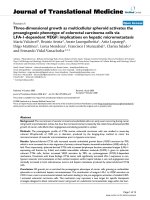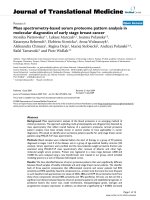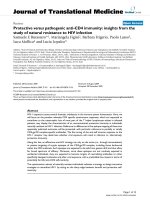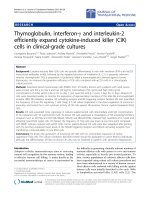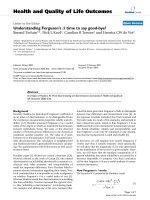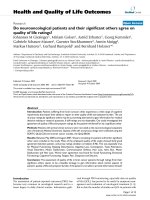báo cáo hóa học:" Protective CD8+ T-cell responses to cytomegalovirus driven by rAAV/GFP/IE1 loading of dendritic cells" pdf
Bạn đang xem bản rút gọn của tài liệu. Xem và tải ngay bản đầy đủ của tài liệu tại đây (758.96 KB, 8 trang )
BioMed Central
Page 1 of 8
(page number not for citation purposes)
Journal of Translational Medicine
Open Access
Research
Protective CD8+ T-cell responses to cytomegalovirus driven by
rAAV/GFP/IE1 loading of dendritic cells
Yuefei Yu
†1
, Petra Pilgrim
†1
, Juqiang Yan
1
, Wei Zhou
1
, Marjorie Jenkins
2
,
Nicoletta Gagliano
1,3
, Klaus Bumm
1,4
, Martin Cannon
5
, Aldo Milzani
6
,
Isabella Dalle-Donne
6
, W Martin Kast
7,8
, Everardo Cobos
1
and
Maurizio Chiriva-Internati*
1,8
Address:
1
Division of Hematology & Oncology, Texas Tech University Health Sciences Center and Southwest Cancer Treatment and Research
Center, Lubbock, TX, USA,
2
Departments of Internal Medicine and Obstetrics & Gynecology, and the Laura W. Bush Institute for Women's Health
and Center for Women's Health and Gender-Based Medicine, Texas Tech University Health Sciences Center, Amarillo, TX, USA,
3
Department of
Human Morphology, University of Milan, Italy,
4
Department of Otorhinolaryngology, Head & Neck Surgery, University of Erlangen-Nuremberg,
FAU Medical School, Erlangen, Germany,
5
Department of Microbiology and Immunology, University of Arkansas for Medical Sciences, AR, USA,
6
Department of Biology, University of Milan, Milan, Italy,
7
Departments of Molecular Microbiology & Immunology and Obstetrics & Gynecology,
Norris Comprehensive Cancer Center, University of Southern California, Los Angeles, CA, USA and
8
Kiromic, Inc., Lubbock, TX, USA
Email: Yuefei Yu - ; Petra Pilgrim - ; Juqiang Yan - ;
Wei Zhou - ; Marjorie Jenkins - ; Nicoletta Gagliano - ;
Klaus Bumm - ; Martin Cannon - ; Aldo Milzani - ; Isabella Dalle-
Donne - ; W Martin Kast - ; Everardo Cobos - ; Maurizio Chiriva-
Internati* -
* Corresponding author †Equal contributors
Abstract
Background: Recent studies demonstrate that recombinant adeno-associated virus (rAAV)-based
antigen loading of dendritic cells (DCs) generates in vitro, significant and rapid cytotoxic T-
lymphocyte (CTL) responses against viral antigens.
Methods: We used the rAAV system to induce specific CTLs against CVM antigens for the
development of cytomegalovirus HCMV) gene therapy. As an extension of the versatility of the
rAAV system, we incorporated immediate-early 1 (IE1), expressed in HCMV. Our rAAV vector
induced a strong stimulation of CTLs directed against the HCMV antigen IE1. We then investigated
the efficiency of the CTLs in killing IE1 targeted cells.
Results: A significant MHC Class I-restricted, anti-IE1-specific CTL killing was demonstrated
against IE1 positive peripheral blood mononuclear cells (PBMC) after one, in vitro, stimulation.
Conclusion: In summary, single PBMC stimulation with rAAV/IE1 pulsed DCs induces strong
antigen specific-CTL generation. CTLs were capable to lyse low doses of peptides pulsed into
target cells. These data suggest that AAV-based antigen loading of DCs is highly effective for
generating human CTL responses against HCMV antigens.
Published: 5 October 2008
Journal of Translational Medicine 2008, 6:56 doi:10.1186/1479-5876-6-56
Received: 31 May 2008
Accepted: 5 October 2008
This article is available from: />© 2008 Yu et al; licensee BioMed Central Ltd.
This is an Open Access article distributed under the terms of the Creative Commons Attribution License ( />),
which permits unrestricted use, distribution, and reproduction in any medium, provided the original work is properly cited.
Journal of Translational Medicine 2008, 6:56 />Page 2 of 8
(page number not for citation purposes)
Background
Over the past few years, overwhelming evidence has come
to light that inflammation hidden deep in the body is a
common source of heart attacks, even when clogging of the
arteries by plaque is minimal [1]. A leading cause is infec-
tion by various microbes, in particular, the human cytome-
galovirus (HCMV), which historically has been linked to
heart/arterial disease [2-15]. Existing drugs for the treatment
or prevention of HCMV disease are only partially effective,
have a variety of side effects, and may fail because of drug
resistant mutations [12,16,17]. An effective HCMV gene
therapy would provide a great medical benefit and would
also result in annual savings in the cost of caring for persons
with HCMV disease. Although immunotherapeutic inter-
ventions are promising, current treatments to induce strong
immune responses against HCMV are still inadequate. In
order to develop a new method to induce strong immune
responses against HCMV, we used the rAAV-based antigen
loading of DCs to generate significant and specific CTL
responses against HCMV antigens. Several HCMV proteins
have been shown to serve as target antigens for the class I-
restricted CD8+ T cell responses against HCMV, including
the major immediate-early protein (IE) [18], glycoprotein B
(gB) [18], and non-envelope structural virion proteins, such
as the matrix protein pp65 [19]. Among the IE proteins, two
nuclear regulatory phosphoproteins, IE1 and IE2, are the
first and most abundantly expressed proteins and are syn-
thesized by differential splicing from the same complex
overlapping transcription unit within the major IE (MIE)
locus [20]. Early analyses of the CTL response in seroposi-
tive individuals have suggested that the 72-kDa immediate-
early protein IE1 was a dominant target for CD8
+
CTLs [18].
IE1 is the major protein produced in the immediate-early
phase of the human HCMV replication cycle and has been
shown to be target for CD4
+
and CD8
+
T cells [21]. IE1 was
the first gene product identified to elicit CTL responses in
mice [22]. The role of IE1-recognizing CD8+ T cells will be
an interesting subject to study. DCs are professional antigen
presenting cells that are critical to prime a cellular immune
response [12,23-25]. There is evidence of several protocols
for loading DCs, based on the use of tumor antigens such as
peptides, lysed tumors, whole proteins, and genes expressed
on plasmids or viral vectors [26,27]. These new technolo-
gies permit in vitro manipulation of DCs for clinical studies
[12,28,29].
Recent studies demonstrate that recombinant rAAV-based
antigen loading of DCs generates significant and rapid
CTL responses in vitro [12,19,30]. rAAV has been widely
studied in applications to transduce DCs. rAAV lacks viral
coding sequences, therefore the transduced DCs only
express antigen proteins and not viral proteins [31]. Fur-
ther, rAAV does not elicit an immune response in its host,
therefore there is no secondary inflammation in the host
due to rAAV [31].
In the present study, IE1 genes were cloned into AAV to
test the ability of r-AAV loading of DCs to generate specific
CTL responses against IE1 positive cells.
Methods
Cell culture and patients material
The HEK293 cells were maintained and propagated in
complete DMEM supplemented with penicillin and strep-
tomycin (Mediatech Inc., Herndon, VA) and 10% FBS
(Gemini Bio-Products, West Sacramento, CA). Autolo-
gous peripheral blood mononuclear cells (PBMCs) and
were obtained from 3 female HLA-A2 restricted healthy
donors. All of the clinical materials were obtained with
the patient's consent and approval by the local ethics
committee.
Constructing the AAV/IE1 genome and generation of virus
stocks
The AAV/IE1 genome was constructed as a plasmid as pre-
viously described [28,30]. Briefly, the IE1 gene was ampli-
fied by PCR from plasmid pCGN-IE1, which was kindly
provided by Dr. Thomas Shenk at the Department of
Molecular Biology, Princeton University. PCR amplifica-
tion for IE1 was carried out using the following primer
pair: upstream, 5'-GGTACCATGGAGTCCTCTGCCAAGA-
3'; downstream, 5'-CTCGAGGACCTTGTACTCATTACA-
CATTG-3'. AAV/IE1 virus stocks were generated using
complementary plasmids ins96-0.8 or pSH3, using
HEK293 cells as described previously [28,30,32]. Lysates
of HEK293 cells were used as virus-negative controls for
mock infections.
Immunofluorescence
HEK293 cells were spun in a cytospin column (5 × 10
4
cells/slide), fixed with SlideRite (Fisher, USA), and air
dried overnight. Each sample was permeabilized (P) in
PBS 1×/0.1% Triton X-100 for 15 minutes at 4°C not per-
meabilized (NP). Results were analyzed using an Olym-
pus IX71 inverted microscope equipped with a Fluoview
300 confocal laser system.
Real-time PCR for virus stock titration
The titer of virus stocks was determined by real-time PCR
as previously described [32]. Briefly, we used the plasmid
AAV/IE1 for the real-time PCR standards, respectively.
Concentration was measured by absorbance at 260 nm.
Generation and infection of monocyte-derived DCs
Autologous DCs (2 × 10
5
adherent monocytes) were gen-
erated and infected (0.5 mL virus [10
9
eg/mL]) as previ-
ously described [28,30]. Recombinant granulocyte
macrophage-colony-stimulating factor (GM-CSF) (R&D
Systems, Minneapolis, MN, USA), at a final concentration
of 800 IU/mL, was included in the medium throughout
the culture. To induce monocytes into DCs, human inter-
Journal of Translational Medicine 2008, 6:56 />Page 3 of 8
(page number not for citation purposes)
leukin-4 (IL-4) (R&D Systems, Minneapolis, MN, USA) at
1000 IU/mL was added on day 3, after infection.
Generation of autologous 1E1-positive target cells
Non-adherent PBMCs, isolated from healthy donors, were
infected with AAV/IE1 virus at a multiplicity of infection
of 100, 4 days before the
51
Cr release assay.
Lipofection using DOTAP
The recombinant IE1 protein was made as previous
described [33]. Lipofection was performed using the cati-
onic liposome-mediated transfection reagent, DOTAP
(Roche Diagnostics, Indianapolis, IN). IE1 protein was
mixed with the DOTAP reagent and serum-free media at
ratios following the manufacturer's recommendations.
The cells were then incubated in serum-free media con-
taining the lipofection mix for 4–6 hours. Final IE1 con-
centration was 100 nM for the DCs and PBMCs. After 4–6
hours of incubation, serum-supplemented DMEM was
added to cells. After 24 hours, all of the lipofection media
was replaced with fresh growth media for cells.
Generation and testing of 1E1-specific CTLs
CTL were generated from 3 normal donors (HLA
matched). Experiments were performed in quadruplicate
(experiments were preformed 4 times independently with
different ratios of responders to DCs from 5:1; 10:1; 20:1;
40:1 data not provided) [23,24]. For each experiment, the
non-adherent PBMCs were washed and re-suspended in
AIM-V at 10 to 20 × 10
6
cells per well in 6-well culture
plates with AAV/IE1-loaded autologous DCs (optimal
ratios of responders to DCs from 20:1). The cultures were
supplemented with GM-CSF (800 U/mL) and recom-
binant human IL-2 (10 U/mL). After 7 days of co-culture,
the cells were used for cytotoxicity assays in a 6-hour
51
Cr
assay, as previously described [16,23,24]. To determine
the CTLs' HLA restriction, HLA-class I (W6/32) of anti-
bodies, at a concentration of 25 μg/mL, were pre-incu-
bated with the target cells for 30 minutes before addition
of the stimulated T-cells. K562 cells were used as targets to
observe natural killer (NK) cell activity. In all of these CTL
killing assays, spontaneous release of chromium never
exceeded 25% of the maximum release [23,24].
Flow cytometry analysis
This protocol was adapted from that described by Pala et
al. and modified [24,28]. Cell surface marker analysis of T
cells and DCs was conducted using fluorescence-activated
cell scanning (FACS) (FACScan; BD Biosciences-PharMin-
gen, Franklin Lakes, NJ), as described previously [24,28].
Statistical analysis
All results are expressed as mean ± SD. Data were analyzed
using nonparametric analysis of variance (ANOVA). Dif-
ferences were considered significant if P < 0.05.
Results
Construction of AAV/IE1 Recombinant Viruses
The goal of this study was to determine whether rAAV-
based gene loading of IE1 genes into DCs could elicit a
significant CTL response against IE1-positive target cell
lines. This was the first time that the gene encoding IE1
was inserted into the AAV vector. First, the IE1 gene was
amplified by PCR from plasmid pCGN-IE1. The IE1 cDNA
obtained from pCGN-IE1 was inserted into the gutted
AAV vector to generate AAV/IE1 as described in the mate-
rials and methods section. Figure 1A shows a structural
map of the AAV/IE1 vector. In this vector, the IE1 gene was
expressed from the AAV p5 promoter, which is known to
be active in DCs [31]. After rAAV vector generation, we
evaluated their ability to infect HEK293 cells. The rAAV-
vector infected cells expressed the target antigens, as con-
firmed by immunofluorecence labeling, which showed
the expression of IE1 transduced HEK293 cells. (Figure 1)
Titration of AAV/IE1 virus stocks using real-time PCR
assays
Virus stock titers were determined by real-time PCR (Fig-
ure 2). We assessed the linearity of the real-time PCR by
using a dilution row of the AAV/IE1 plasmid that would
serve as standard curve in all further experiments. The
obtained fragments corresponded to the expected size and
no additional bands could be detected by gel electro-
phoresis, showing the specificity and selectivity of the
PCR. We did not observe signals from the template sam-
ple in either the amplification plot or the agarose gel pho-
tograph (data not shown).
AAV/IE1-transduced DCs express 1E1
Protocols for generating DCs by differentiating PBMCs
usually involve the use of GM-CSF and IL-4 during adher-
Immunofluorescence on HEK293 cellsFigure 1
Immunofluorescence on HEK293 cells. Microphoto-
graphs show fluorescent labeling for AAV/IE1 (A, B) in
HEK293 cells. A: original magnification: 20×; B: original mag-
nification: 63×.
Journal of Translational Medicine 2008, 6:56 />Page 4 of 8
(page number not for citation purposes)
ent monocyte culturing. We modified this protocol to
promote AAV vector transduction in DC precursor mono-
cytes by treating adherent monocytes just after AAV infec-
tion with GM-CSF alone, adding IL-4 on day 3. This
method allowed higher levels of AAV transduction [34].
Figure 1B shows a schematic diagram of the experimental
protocol. Monocyte/DC population transduction was
confirmed by measuring polyadenylated RNA expression
of the AAV/IE1 transgene. At day 10, polyadenylated RNA
was isolated from AAV/IE1-infected and mock-infected
DC cultures. The mRNA levels were analyzed by RT-PCR
for AAV/IE1 expression. A cellular housekeeping gene,
TF
II
B, was included as a control. IE1 mRNA expression
took place only in the infected DCs (Figure 3). A PCR-only
control (no RT step) failed to generate a product, indicat-
ing that there was no DNA contamination in our samples.
AAV/IE1-transduced DCs stimulated AAV/IE1-specific CTLs
We analyzed the ability of the AAV/IE1 vectors to generate
IE1 specific-CTLs (optimal ratio E:T; 1:20). To analyze
CTL activity, we used the following 5 target cell types for
the
51
Cr release assays (Figures 4, 5, 6): 1) Autologous
PBMCs. Because late B cells are only a small percentage of
PBMCs, PBMCs served as an autologous, antigen-negative
control; 2) PBMCs transfected with AAV/IE1 expression
plasmid; 3) PBMCs transfected with AAV only and AAV/
GFP, as a negative controls; 4) PBMCs transfected with E6,
as a control; 5) PBMCs transfected with IE1 protein.
To determine the ability of AAV/IE1-transduced DCs to
stimulate IE1-specific CTLs, we performed a standard 6-
hour51Cr assay on day 7 using a 1:20 (ratio: Effector:Tar-
get) (Figure 5) using the T-cell populations primed in co-
culture with the rAAV-transduced DCs [30]. We generated
autologous targets by infecting donor PBMCs with AAV/
IE1 virus 4 days before the CTL assay. AAV/IE1-infected
PBMCs were found to express IE1 by RT-PCR analysis,
whereas unaltered PBMCs and K562 cells did not express
IE1 (data not shown). T-cells incubated with AAV/IE1-
loaded DCs were able to kill the IE1-positive autologous
target cells. These data are consistent with a strong anti-
gen-specific CTL response. Figure 7 shows that CTL killing
activity was dose-dependent and MHC class I restricted. In
this experiment, 2 different doses of AAV/IE1 vector were
used for DC loading and a zero virus control (PBMC
only). The cytotoxicity of the stimulated T-cells directly
correlated with the amount of AAV/IE1 used to load the
Virus stock titersFigure 2
Virus stock titers. DNA extracted from the purified virus
of AAV/IE1 was used as the template of PCR. The DNA from
1000 μl, 500 μl and 250 μl purified virus was tested, respec-
tively. We used three blank wells, with water, as negative
controls. EG = encapsulated genomes.
IE1 expression in infected DCsFigure 3
IE1 expression in infected DCs. Total RNA was isolated
from mock-infected and AAV/IE1-infected adherent mono-
cytes at 72 hours after infection. These samples were ana-
lyzed by RT-PCR and PCR, as indicated, for the presence of
IE1 RNA. PCR product resulting from using the AAV/IE1 vec-
tor plasmids as templates was the positive controls. RT-PCR
analysis for the cellular TFIIB mRNA was considered as fur-
ther control. Note that only cDNA from cells infected with
AAV/IE1 virus resulted in an appropriate RT-PCR sized prod-
uct, whereas mock-infected cells did not.
Cytotoxicity assayFigure 4
Cytotoxicity assay. Multiple AAV vectors for DC loading
and the autologous targets generated using the IE1 sub-
genes. Targets were generated by viral loading of the IE1 sub-
genes into PBMC. Resulting CTL killing is shown. Note that T
cells stimulated by mock-infected (no Ag) loaded DCs, AAV
only-loaded DCs AAV/GFP-loaded DCs AAV/E6-loaded DCs
did not kill IE1-positive targets. However, T cells stimulated
by AAV/GFP/IE1-loaded DCs did kill IE1-positive target cells.
These data strongly suggest high antigen-loading specificity of
the CTLs generated by AAV/GFP/IE1 infection of DCs.
Journal of Translational Medicine 2008, 6:56 />Page 5 of 8
(page number not for citation purposes)
DCs at day 0. Alternately, the addition of anti-class I anti-
bodies significantly inhibited the killing activity (P <
0.05), suggesting that CTLs were MHC class I restricted.
The CTL stimulation performed by AAV/IE1 loaded DCs
was superior to the one performed by IE1 protein lipofec-
tion (P < 0.05). The negative controls (K562 and the tar-
gets pre-incubated with anti-MHC class I antibodies) did
not induce significant killing activity. These data showed
CTLs to be highly AAV/IE1 specific and MHC class I
restricted. Figure 7 demonstrates that the use of AAV/GFP/
IE1 loading DCs resulted in a higher delivery effect (80%)
than IE1 protein lipofected DCs did (15%).
Discussion
To achieve effective antivirus responses, recent emphasis
has been placed on approaches that stimulate strong cel-
lular immune responses, which are mediated by T-cells
and particularly by CTLs. CTLs are believed to be the crit-
ical immune effector arm in mediating potential antivirus
immunity. CD8
+
CTLs play a major role in protection
against HCMV and in maintenance of its latency [35-38].
It has been hypothesized that antigen gene delivery into
DCs [23,24] may be more efficient for generating CTLs
than by antigen delivery as a lipofected, exogenous pro-
tein [23,24,28]. Although there is some controversy as to
AAV effectiveness in transducing DCs and other hemat-
opoietic cells, donor monocytes/DCs have been shown to
be successfully transduced with AAV-2 [23,24,28,30]. Fur-
thermore, in various studies, AAV has been shown to be
an effective gene-delivery system for immortalized tissue-
cultured cells and primary hematopoietic cells [34,39-41].
The AAV vectors were found to transduce up to 85% of
DCs [12,19,23,24]. The transduced DCs displayed higher
levels of CD80, CD83, CD86, and CD1a over controls. In
fact, the DC-loading technique was found to be highly
effective in generating significant CTLs with only one DC-
T-cell co-incubation and in a time frame of only 1 week.
We confirm that rAAV-infected monocytes with GM-CSF
only and then adding IL-4 after 3 days induces DCs' differ-
entiation [23,24]. Previous studies showed that rAAV-
loading DCs can rapidly generate antigen-specific CTLs
against viral antigens [16]. The IE1 protein has been pro-
posed as a target for immunotherapy. The IE genes are the
first ones to be expressed in the replicative cycle, and their
expression does not depend on prior viral protein synthe-
sis. Together with some virion proteins, the IE products
activate viral genes and alter the infected cell to generate
an appropriate milieu that favors viral replication [42].
Cytotoxicity assayFigure 5
Cytotoxicity assay. AAV/GFP/IE1 vectors for DC loading
and multiple targets generated using various vectors. Targets
were generated by IE1 positive and negative vector loading
into PBMC. Resulting CTL killing is shown. IE1 negative
PBMCs (no Ag) and K562 cells were not killed, indicating
strong antigen specificity for the CTLs generated by AAV/IE1
loading.
Cytotoxicity assayFigure 6
Cytotoxicity assay. Killing was stimulated in a dose-
dependent manner. Killing activity was significantly inhibited
when target cells were pre-incubated with anti-class I anti-
bodies (P < 0.05). Similarly, the killing activity of DC trans-
duced with AAV/GFP/IE1 showed a significant higher (P <
0.05) than IE1 protein lipofection using DOTAP did.
Flow cytometric characterizationFigure 7
Flow cytometric characterization. Shown are the
results of FACS analysis for the antigen delivery. Note that
the use of AAV/GFP/IE1 loading DC resulted in a higher
delivery effect (80%) than IE1 protein lipofected DC did
(15%).
Journal of Translational Medicine 2008, 6:56 />Page 6 of 8
(page number not for citation purposes)
Human cytomegalovirus (HCMV) IE1, the most abun-
dant IE product, plays an accessory role in the IE2-medi-
ated activation of HCMV early and late genes [43,44].
Interaction of HCMV IE1 with a number of cellular regu-
latory proteins has also been described previously [45]. In
addition to their regulatory activities, HCMV IE1 is
involved in perturbing a variety of other cellular proc-
esses, including cell cycle regulation [46,47], apoptosis
[48], and cell architecture. The IE1 protein of HCMV is a
major source of CD8 T-cell epitopes for HLA molecules
represented in a large proportion of the human popula-
tion, and plays a significant role in the control of HCMV
disease [49]. The previous study led to the identification
of several new classes of I MHC-restricted CTL epitopes
against IE1 antigens [50]. This result was confirmed by
another study in which several IE1 HLA class I epitopes
were detected and no IE1 class II epitopes were identified
[51].
Here we have demonstrated that rAAV-loading of DCs
with IE1 can generate antigen-specific CTLs in substantial
numbers, only 1 week after stimulation. Based on this and
our previous studies, we hypothesize that the AAV vector
causes a fundamental change in DC performance, perhaps
by modifying their co-stimulatory ligand expression,
resulting in more efficient generation of antigen-specific
CTLs [28]. We hypothesized that the AAV/IE1 would be
superior to IE1 protein in stimulating CTL killing. Our
experiments show that AAV/IE1 was much more efficient
in stimulating the killing of target cells than IE1 protein (P
< 0.05). Our controls (Figures 5, 6, 7) show strong antigen
specificity and MHC class I restriction. For example, Fig-
ure 5 shows that autologous PBMCs were not targeted for
killing unless these target were preloaded with the anti-
gen. Without loading the antigen, there is no significant
killing. Furthermore, K562 cells are shown in Figures 4, 5,
6 to be insignificant targets.
This same report [51] suggested that IE1 is directly related
to CTL killing and the importance of MHC class I mole-
cules as a restriction element in HCMV. Our results prove
a direct link between the IE1 protein and CTL recognition.
We believe it is likely that there are multiple reasons why
AAV loading of DCs is effective. One reason is the high
transduction frequency we have observed. A second rea-
son could be the increased expression of CD80, CD86,
and CD40 that may also contribute to generating the
robust CTL response.
Conclusion
In summary, our results demonstrate that the delivery of
IE1 antigen by an AAV vector is a good strategy for gener-
ating anti-IE1 CTLs. Our data suggest that AAV-based anti-
gen loading of DCs is highly effective for generating a CTL
response against HCMV.
Competing interests
The authors declare that they have no competing interests.
Authors' contributions
YY performed protein and AAV generation and all PCR
experiments and drafted the manuscript. PP performed
immunofluorescence experiments and drafted the manu-
script. JY performed AAV generation and all PCR experi-
ments. WZ performed AAV generation and all PCR
experiments. MJ participated in study design and coordi-
nation and revised the manuscript. NG participated in the
design of the study and revised and drafted the manu-
script. KB participated in the design of the study and
revised and drafted the manuscript. MC participated in
study design and coordination and revised and drafted the
manuscript. AM participated in the design of the study
and revised and drafted the manuscript. IDD participated
in the design of the study and revised and drafted the
manuscript. WMK participated in study design and coor-
dination and revised and drafted the manuscript. EC par-
ticipated in study design and coordination and revised the
manuscript. MCI carried out the study design, FACS anal-
ysis and killing assay and drafted and revised the manu-
script. All authors read and approved the final
manuscript.
Acknowledgements
This project was supported by the Institutional Research Program of the
Texas Tech University Health Sciences Center, the Southwest Cancer
Treatment and Research Center Program, the Laura W. Bush Institute for
Women's Health and Center for Women's Health and Gender-Based Med-
icine, Texas Tech University Health Sciences Center. Cardiovascular
TTUHSC Seed Grant.
The authors thank Teri Fields for her assistance in editing this manuscript.
W. Martin Kast holds the Walter A. Richter Cancer Research Chair.
References
1. Ridker PM, Cushman M, Stampfer MJ, Tracy RP, Hennekens CH:
Inflammation, aspirin, and the risk of cardiovascular disease
in apparently healthy men. N Eng J Med 1997, 336:973-979.
2. Adam E, Melnick JL, DeBakey ME: Cytomegalovirus infection and
atherosclerosis. Cent Eur J Public Health 1997, 5:99-106.
3. Bolovan-Fritts CA, Trout RN, Spector SA: Human cytomegalovi-
rus-specific CD4+- T-cell cytokine response induces fractalk-
ine in endothelial cells. J Virol 2004, 78:13174-13181.
4. Froberg MK, Adams A, Seacotte N: Cytomegalovirus infection
accelerates inflammation in vascular tissue overexpressing
monocyte chemoattractant protein-1. Circ Res 2001,
89:1224-1230.
5. Kendall TJ, Wilson JE, Radio SJ, Kandolf R: Cytomegalovirus and
other herpesviruses: do they have a role in the development
of accelerated coronary arterial disease in human heart allo-
grafts? J Heart Lung Transplant 1992, 11:S14-20.
6. Koskinen PK, Kallio EA, Tikkanen JM: Cytomegalovirus infection
and cardiac allograft vasculopathy. Transpl Infect Dis 1999,
1:115-126.
7. Koskinen P, Lemstrøm K, Mattila S: Cytomegalovirus infection
associated accelerated heart allograft arteriosclerosis may
impair the late function of the graft. Clin Transplant 1996,
10:487-493.
8. Koskinen P, Lemström K, Bruggeman C: Acute cytomegalovirus
infection induces a subendothelial inflammation (endotheli-
Journal of Translational Medicine 2008, 6:56 />Page 7 of 8
(page number not for citation purposes)
alitis) in the allograft vascular wall. A possible linkage with
enhanced allograft arteriosclerosis. Am J Pathol 1994,
144:41-50.
9. Lozinguez O, Arnaud E, Velut JG: Cytomegalovirus and arterial
disease. Current aspects. Arch Mal Coeur Vaiss 1999,
92:1205-1212.
10. Melnick JL, Adam E, Debakey ME: Cytomegalovirus and athero-
sclerosis. Eur Heart J 1993, 14(suppl K):30-38.
11. Petrakopoulou P, Kübrich M, Pehlivanli S: Cytomegalovirus infec-
tion in heart transplant recipients is associated with
impaired endothelial function. Circulation 2004, 110:207-212.
12. Scheller N, Furtwangler R, Sester U, Maier R, Breinig1 T, Meyerhans
A: Human cytomegalovirus protein pp65: an efficient protein
carrier system into human dendritic cell. Gene Ther 2008,
15:318-325.
13. Schönian U, Maisch B: Cytomegalovirus associated diseases of
the heart. Herz 1992, 17:85-90.
14. Tu W, Potena L, Stepick-Biek P: T-cell immunity to subclinical
cytomegalovirus infection reduces cardiac allograft disease.
Circulation 2006, 114:1561-1564.
15. Zakliczyński M, Krynicka-Mazurek A, Pyka Ł: The influence of
cytomegalovirus infection, confirmed by pp65 antigen pres-
ence, on the development of cardiac allograft vasculopathy.
Transplant Proc 2007, 39:2866-2869.
16. Paya CV: Prevention of cytomegalovirus disease in recipients
of solid-organ transplants. Clin Infect Dis 2001, 32:596-603.
17. Zaia JA: Prevention of cytomegalovirus disease in hematopoi-
etic stem cell transplantation. Clin Infec Dis 2002, 35:999-1004.
18. Borysiewicz L, Hickling J, Graham S, Sinclair J, Cranage M, Smith G,
Sissons J: Human cytomegalovirus specific cytotoxic T cells
relative treatment of stage specific CTL recognizing the 72
kD immediate early protein and glycoprotein B expressed by
recombinant vaccinia viruses. J Exp Med 1988, 168:919-931.
19. McLaughlin-Taylor E, Pande H, Forman SJ, Tanamachi B, Li CR, Zaia
JA, Greenberg PD, Riddell SR: Identification of the major late
human cytomegalovirus matrix protein pp65 as a target
antigen for CD8+ virus-specific cytotoxic T lymphocytes. J
Med Virol 1994, 43:103-110.
20. Lee HR, Kim DJ, Lee JM, Choi CY, Ahn BY: Ability of the human
cytomegalovirus IE1 protein to modulate sumoylation of
PML correlates with its functional activities in transcrip-
tional regulation and infectivity in cultured fibroblast cells. J
Virol 2004, 78:6527-6542.
21. Vaz-Santiago J, Lulé J, Rohrlich P, Jacquier C, Gibert N: Ex vivo stim-
ulation and expansion of both CD4
+
and CD8
+
T cells from
peripheral blood mononuclear cells of human cytomegalovi-
rus-seropositive blood donors by using a soluble recom-
binant chimeric protein, IE1-pp65. J Virol 2001, 75:7840-7847.
22. Reddehase MJ, Koszinowski UH: Significance of herpesvirus
immediate-early gene expression in cellular immunity to
cytomegalovirus infection. Nature 1984, 312:369-371.
23. Chiriva-Internati M, Liu Y, Weidanz JA, Grizzi F, You H, Zhou W:
Testing recombinant adeno-associated virus-gene loading of
dendritic cell for generating potent cytotoxic T lymphocytes
against a prototype self-antigen, multiple myeloma HM1.24.
Blood 2003, 102:3100-3107.
24. Liu Y, Chiriva-Internati M, Grizzi F, Salati E, Roman J, Lim S: Rapid
induction of cytotoxic t-cell antigen gene deliver into human
dendritic cells by an adeno-associated virus vector. Cancer
Gene Ther 2001, 8:948-957.
25. Ponnazhagan S, Mahendra G, Curiel D, Shaw D: Adeno-associated
virus type 2-mediated transduction of human monocyte-
derived dendritic cells: implications for ex vivo immuno-
therapy. J Virol 2001, 10:9493-9501.
26. Romani NS, Gruner D, Brang E, Kampgen E, Lenz A, Trockenbacher
B, Konwalinka G, Fritsch PO, Steinman RM, Schuler G: Proliferating
dendritic cell progenitors in human blood. J Exp Med 1994,
180:83-93.
27. Sallusto F, Lanzavecchia A: Efficient presentation of soluble anti-
gen by cultured human dendritic cells is maintained by gran-
ulocyte/macrophage colony-stimulating factor plus
interleukin 4 and downregulated by tumor necrosis factor
alpha. J Exp Med 1994, 179:1109-1118.
28. Chiriva-Internati M, Liu Y, Salati E, Zhou W, Wang Z, Grizzi F, Roman
JJ, Lim SH, Hermonat PL: Efficient generation of cytotoxic T
lymphocytes against cervical cancer cells by adeno-associ-
ated virus/human papillomavirus type 16 E7 antigen gene
transduction into dendritic cells. Eur J Immunol 2002, 32:30-38.
29. Young JW, Inaba K: Dendritic cells as adjuvants for class I major
histocompatibility complex-restricted antitumor immunity.
J Exp Med 1996, 183:7-11.
30. Liu Y, Santin AD, Mane M, Chiriva-Internati M, Parham GP, Ravaggi A,
Hermonat PL: Transduction and utility of the granulocyte-
macrophage colony stimulating factor gene into dendritic
cells by adeno-associated virus. J Interferon Cytokine Res 2000,
20:21-30.
31. Pala P, Verhoef A, Lamb JR, Openshaw PJ: Single cell analysis of
cytokine expression kinetics by human CD4
+
T-cell clones
during activation or tolerance induction. Immunology 2000,
100:209-216.
32. Veldwijk MR, Topaly J, Laufs S, Hengge UR, Wenz F, Zeller WJ, Frue-
hauf S: Development and optimization of a real time quanti-
tative PCR-based method for the titration of AAV-2 vector
stocks. Mol Ther 2002, 6:272-278.
33. Yu Y, Wen B, Niu D, Chen M, Qiu L: Induction of Protective
Immunity Against Scrub Typhus with a 56-Kilodalton
Recombinant Antigen Fused with a 47-Kilodalton Antigen of
Orientia tsutsugamushi Karp. Am J Trop Med Hyg 2005,
72:458-464.
34. Podsakoff G, Wong KK Jr, Chatterjee S: Efficient gene transfer
into nondividing cells by adeno-associated virus-based vec-
tors. J Virol 1994, 68(9):5656-5666.
35. Polic B, Hengel H, Krmpotic A, Trgovcich J, Pavic I, Luccaronin P, Jon-
jic S, Koszinowski UH: Hierarchical and redundant lymphocyte
subset control precludes cytomegalovirus replication during
latent infection. J Exp Med 1998, 188:1047-1054.
36. Reddehase MJ, Weiland F, Munch K, Jonjic S, Luske A, Koszinowski
UH: Interstitial murine cytomegalovirus pneumonia after
irradiation: characterization of cells that limit viral replica-
tion during established infection of the lungs. J Virol 1985,
55:264-273.
37. Selin LK, Nahill SR, Welsh RM: Cross-reactivities in memory
cytotoxic T lymphocyte recognition of heterologous viruses.
J Exp Med 1994, 179:1933-1943.
38. Steffens HP, Kurz S, Holtappels R, Reddehase MJ: Preemptive CD8
T-cell immunotherapy of acute cytomegalovirus infection
prevents lethal disease, limits the burden of latent viral
genomes, and reduces the risk of virus recurrence. J Virol
1998, 72:1797-1804.
39. Fisher-Adams G, Wong KK Jr, Podsakoff G, Forman SJ, Chatterjee S:
Integration of adeno-associated virus vectors in CD34
+
human hematopoietic progenitor cells after transduction.
Blood 1996, 88:492-504.
40. Hermonat PL, Muzyczka N: Use of adeno-associated virus as a
mammalian DNA cloning vector: transduction of neomycin
resistance into mammalian tissue culture cells. Proc Natl Acad
Sci USA 1984, 81:6466-6470.
41. Zhou SZ, Broxmeyer HE, Cooper S, Harrington MA, Srivastava A:
Adeno-associated virus 2-mediated gene transfer in murine
hematopoietic progenitor cells. Exp Hematol 1993, 21:928-933.
42. Ghazal P, Visser AE, Gustems M, García R, Borst EM, Sullivan K, Mes-
serle M, Angulo A: Elimination of ie1 significantly attenuates
murine cytomegalovirus virulence but does not alter replica-
tive capacity in cell culture. J Virol 2005, 79:7182-7194.
43. Malone CL, Vesole DH, Stinski MF: Transactivation of a human
cytomegalovirus early promoter by gene products from the
immediate-early gene IE2 and augmentation by IE1: muta-
tional analysis of the viral proteins. J Virol 1990,
64(4):1498-1506.
44. Stenberg RM, Fotney J, Barlow SW, Magrane BP, Nelson JA, Ghazal P:
Promoter-specific trans activation and repression by human
cytomegalovirus immediate-early proteins involves com-
mon and unique protein domains. J Virol 1990, 64:1556-1565.
45. Poma EE, Kowalik TF, Zhu L, Sinclair JH, Huang ES: The human
cytomegalovirus IE1–72 protein interacts with the cellular
p107 protein and relieves p107-mediated transcriptional
repression of an E2F-responsive promoter. J Virol 1996,
70:7867-7877.
46. Chee AV, Roizman B: Herpes simplex virus 1 gene products
occlude the interferon signaling pathway at multiple sites. J
Virol 2004, 78:4185-4196.
Publish with BioMed Central and every
scientist can read your work free of charge
"BioMed Central will be the most significant development for
disseminating the results of biomedical research in our lifetime."
Sir Paul Nurse, Cancer Research UK
Your research papers will be:
available free of charge to the entire biomedical community
peer reviewed and published immediately upon acceptance
cited in PubMed and archived on PubMed Central
yours — you keep the copyright
Submit your manuscript here:
/>BioMedcentral
Journal of Translational Medicine 2008, 6:56 />Page 8 of 8
(page number not for citation purposes)
47. Wiebusch L, Hagemeier C: Human cytomegalovirus 86-kilodal-
ton IE2 protein blocks cell cycle progression in G
1
. J Virol 1999,
73:9274-9283.
48. Zhu H, Shen Y, Shenk T: Human cytomegalovirus IE1 and IE2
proteins block apoptosis. J Virol 1995, 69:7960-7970.
49. Pahl-Seibert MF, Juelch M, Podlech J, Thomas D, Deegen P, Redde-
hase MJ, Holtappels R: Highly protective in vivo function of
cytomegalovirus IE1 epitope-specific memory CD8 T cells
purified by T-cell receptor-based cell sorting. J Virol 2005,
79:5400-5413.
50. Retière C, Prod'homme V, Imbert-Marcille BM, Bonneville M, Vié H,
Hallet M: Generation of cytomegalovirus-specific human T-
lymphocyte clones by using autologous B-lymphoblastoid
cells with stable expression of pp65 or IE1 proteins: a tool to
study the fine specificity of the antiviral response. J Virol 2000,
74:3948-3952.
51. Slezak SL, Bettinotti M, Selleri S, Adams S, Marincola FM, Stroncek
DF: CMV pp65 and IE-1 T cell epitopes recognized by healthy
subjects. J Transl Med 2007, 5:17.
52. Collaco RF, Cao X, Trempe JP: A helper virus-free packaging sys-
tem for recombinant adeno-associated virus vectors. Gene
1999:397-405.

